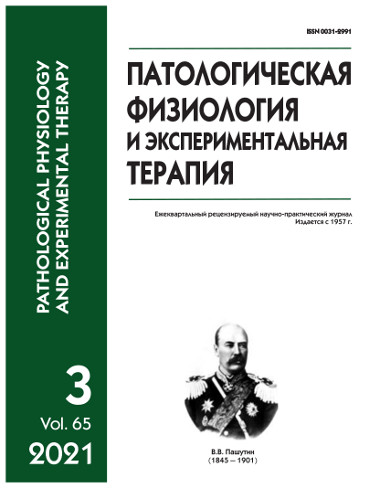Experimental model of acute urate oxalate nephrolithiasis in Wistar rats
Abstract
Introduction. At present, the incidence of urate-oxalate nephrolithiasis has increased. For the development of new methods of pharmacological treatment of this disease, it is necessary to create an adequate model that makes it possible to assess the effectiveness of pharmacotherapy. The aim – create a model of mixed urate-oxalate nephrolithiasis in Wistar rats and to study the biochemical and histological picture of the pathology. Methods. Experiments were carried out on 30 male Wistar rats, divided into a comparison group (n = 10) and an experimental group (n = 20). For formation of urate-oxalate nephrolithiasis, the experimental group was injected daily for 7 days intragastrically a mixture of oxonic and uric acids at doses of 500 and 1000 mg/kg, respectively, and these rats were also provided a drinking 1% solution of ethylene glycol. The activities of lactate dehydrogenase and γ-glutamyl transferase were measured in the urine of both groups. In the kidney homogenate, the concentration of thiobarbiturate-reactive products, total pro-oxidant and antioxidant activity, and activities of glutathione peroxidase, catalase, and superoxide dismutase were measured. Severity of lithogenesis, and inflammation was assessed based on the results of morphological studies. Results. In the urine of rats of the experimental group, the activity of lactate dehydrogenase increased more than 20 times relative to the initial level. In the comparison group, there were no significant biochemical changes. The concentration of thiobarbiturate-reactive substances and the activity of catalase in the kidney homogenate experimental group on the 7th day the were 1.3 and 1.6 times higher, respectively, than those of the comparison group. The total pro-oxidant and total antioxidant activity, as well as the activity of superoxide dismutase, decreased significantly by 3.1, 1.8 and 3.2 times, respectively. In the comparison group, renal calculi were absent, but in the experimental group, they were found in 100% of cases in the number of 20.2 ± 2.4 with an average area of 140.55 ± 47.7 μm2, accompanied by inflammatory and degenerative processes. Conclusion. With a weekly application of a 1% solution of ethylene glycol and a mixture of oxonic and uric acids at doses of 500 and 1000 mg/kg, respectively, a pronounced urate-oxalate nephrolithiasis is formed. This was characterized by an increase in the activity of lactate dehydrogenase in the urine, activation of oxidative processes, and the formation of mixed deposits associated with pronounced inflammatory infiltration, cystic dilatation of the renal tubules, as well as dystrophic changes in the tubular epithelium.






